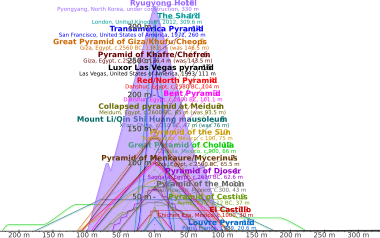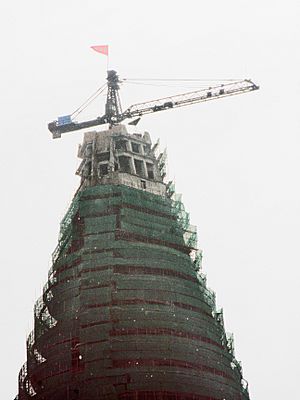Ryugyong Hotel facts for kids
Quick facts for kids Ryugyong Hotel |
|
|---|---|
|
류경호텔
|
|

The Ryugyong Hotel in May 2012
|
|
| General information | |
| Status | On hold |
| Architectural style | Neo-futurism |
| Location | Ryugyong-dong, Potonggang-guyok, Pyongyang, North Korea |
| Coordinates | 39°02′12″N 125°43′51″E / 39.03667°N 125.73083°E |
| Construction started | 28 August 1987 |
| Topped-out | 1992 |
| Estimated completion | Unknown (Exterior construction completed: 14 July 2011) |
| Height | |
| Roof | 330.02 metres (1,082.7 ft) |
| Technical details | |
| Floor count | Above ground 105, Underground 3 |
| Floor area | 360,000 m2 (3,900,000 sq ft) |
| Design and construction | |
| Architect | Baikdoosan Architects & Engineers |
| Developer | Orascom Group |
The Ryugyong Hotel (Korean: 류경호텔) is a huge, pyramid-shaped skyscraper in Pyongyang, North Korea. It has 105 floors and is 330-metre-tall (1,080 ft). Its name means "capital of willows," which is also an old name for Pyongyang. People outside North Korea sometimes call it the "Hotel of Doom" because it has been unfinished for so long.
Construction started in 1987 but stopped in 1992. This happened because North Korea faced money problems after the Soviet Union broke apart. For many years, the building stood empty, without windows or anything inside. Work started again in 2008, and the outside was finished in 2011. The hotel was supposed to open in 2012. This was a special year, marking 100 years since the birth of North Korea's first leader, Kim Il-sung. In 2018, a giant LED display was added to one side. It shows animations and movie scenes.
Contents
What Does the Ryugyong Hotel Look Like?
The Ryugyong Hotel is 330 metres (1,080 ft) tall. This makes it the tallest building in North Korea. It stands out in the skyline of Pyongyang. The building was meant to be finished by 1992. If it had been, it would have been the world's tallest hotel at that time.
The hotel has three long sections, each about 100 metres (330 ft) long. These sections come together at the top to form a point. The very top of the building has a round part that is 40 metres (130 ft) wide. This part has eight floors that were planned to spin around. Above these are six more floors that do not move. The hotel was designed to have five revolving restaurants. It was also planned to have thousands of guest rooms. Today, it is meant to be a mix of hotel rooms, apartments, and business spaces.
Building the Hotel: A Long Story
How the Project Began
The idea for such a big hotel came after South Korea built the world's tallest hotel in Singapore in 1986. North Korea wanted to build an even bigger one. They hoped this project would bring money from other countries. A company was set up to get about $230 million from foreign investors. North Korea's government even said that foreign investors could open casinos and nightclubs there. A North Korean company, Baikdoosan Architects & Engineers, started building the pyramid-shaped hotel in 1987.
The hotel was supposed to open in 1992. This was for the 80th birthday of Kim Il-sung. But there were problems with how it was built and the materials used. This caused delays. If it had opened on time, it would have been the tallest hotel in the world. It would also have been the seventh-tallest building in the world.
Why Construction Stopped
In 1992, the building reached its full height. But then, work stopped completely. This was because North Korea faced a big economic crisis. This crisis happened after the Soviet Union collapsed. For more than ten years, the building stood empty. It had no windows, no furniture, and no inside parts. A rusty construction crane stayed on top. The BBC called it "a reminder of the strict government's failed dream."
Some experts thought the building could not be fixed. They worried about the quality of the concrete. They also wondered if the elevator shafts were straight. In 2008, a North Korean official said construction stopped because they "ran out of money."
Even though the building was a huge part of the Pyongyang skyline, the North Korean government pretended it didn't exist. They even changed official photos to remove it. They also left it off printed maps of Pyongyang. Because of the long stop in building and the mystery around it, foreign news sources called it "the worst building in the world" or the "Hotel of Doom."
Work Starts Again
In April 2008, after 16 years of no activity, work on the hotel began again. An Egyptian company called Orascom Group took over. This company had a deal with North Korea to build a mobile phone network. In 2008, North Korean officials said the hotel would be finished by 2012. This was to celebrate 100 years since the birth of Kim Il-sung. Orascom said they didn't have many problems fixing the building's issues. They also confirmed a revolving restaurant would be at the top.
By July 2011, the outside of the building was finished. Orascom added glass panels and phone antennas. In September 2012, photos showed the inside for the first time. There were still very few things inside.
Plans to Open, Then Cancelled
In November 2012, a hotel company named Kempinski said it would manage the Ryugyong Hotel. They expected it to partly open in mid-2013. But in March 2013, these plans were stopped. Kempinski later said they only had "early talks" and no real agreement. They explained that opening the hotel was "not currently possible."
Kempinski didn't say why, but people thought it was because of tensions related to the 2013 North Korean nuclear test. Money risks and building delays likely also played a part.
New Activity at the Hotel
In late 2016, there were signs that work was starting up again. In 2017 and early 2018, new roads were built around the site. In April 2018, a huge LED display showing the North Korean flag was added to the top. By May, an LED display covered one whole side of the building. Reports said the building was being prepared for people to use it. By July, the LED display was showing animations and movie scenes. In June 2019, new signs with the hotel's name in Korean and English were put over the main entrance.
Images for kids
See also
 In Spanish: Hotel Ryugyong para niños
In Spanish: Hotel Ryugyong para niños
- List of hotels in North Korea
- Korean architecture
- List of buildings with 100 floors or more
- List of tallest hotels
- List of tallest buildings in North Korea











